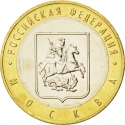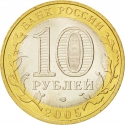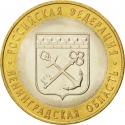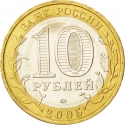You are about to finish your registration. Please check your mailbox (including spam folder). There should be a letter with a confirmation link. Check setting to make sure that your e-mail address is correct.
Send letter againDescription
In 2005 the Central Bank of Russia commenced a series of bi-metallic 10 Rubles coins paying tribute to the regions of the Russian Federation. According to the Russian Constitution, the Russian Federation consists of republics, krais, oblasts, cities of federal importance, an autonomous oblast, and autonomous okrugs, all of which are equal subjects of the Russian Federation. Three Russian cities of federal importance have a status of both city and separate federal subject. In 1993, there were 89 federal subjects listed. By 2008, the number of federal subjects had been decreased to 83 because of several mergers. In 2014, Sevastopol and the Republic of Crimea became the 84th and 85th federal subjects of Russia.
Obverse

|
In the center of the disc indication of the denomination of the coin: 10 RUBLES, inside of the figure 0 hidden pictures of the number 10 and of the inscription RUB visible by turns on changing angle of vision, in the lower part of the disc the mint trade mark MMD, on the ring along the rim above the inscription: BANK OF RUSSIA, below the year of issue 2016, to the left and to the right stylized twigs of plants going over to the disc. БАНК РОССИИ |
|---|---|
Reverse

|
The coat of arms of the Irkutsk Oblast, the inscriptions along the rim divided by two dots: above RUSSIAN FEDERATION, below IRKUTSK OBLAST. • РОССИЙСКАЯ ФЕДЕРАЦИЯ • |
| Edge |
300 corrugations and the inscription ДЕСЯТЬ РУБЛЕЙ (TEN RUBLES) recurring twice and divided by asterisks. ДЕСЯТЬ РУБЛЕЙ ⋆ ДЕСЯТЬ РУБЛЕЙ ⋆ |
10 Rubles
Russian Federation
Irkutsk Oblast
Subscribe series
KM#
Russian Federation
Irkutsk Oblast
Swap now (1 offer)
Characteristics
| Type | Commemorative Issue (Circulating) |
| Material | Bi-Metallic |
| Ring | Brass |
| Center | Cupronickel |
| Weight | 8.4 g |
| Diameter | 27 mm |
| Thickness | 2.1 mm |
| Shape |
|
| Alignment | Medal |
| Mint |
Moscow Mint (MMD)
|







